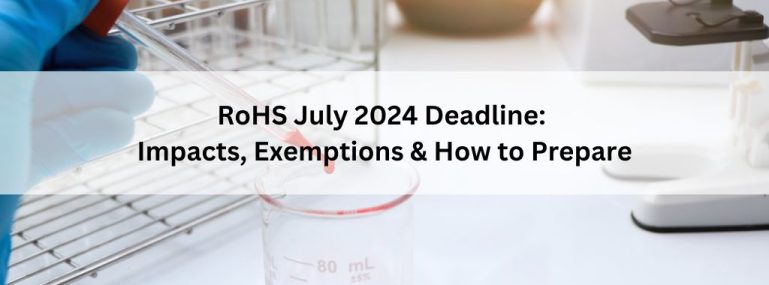The Restriction of Hazardous Substances Directive (RoHS) has been a base regulation in promoting environmental sustainability and ensuring the safety of electronic and electrical equipment (EEE) within the European Union (EU). However, navigating through its exemptions and deadlines can be a complex endeavor for manufacturers and consumers alike. With the upcoming July 21st, 2024 deadline looming, understanding the implications and frequently asked questions (FAQs) surrounding RoHS exemptions becomes paramount.
The upcoming deadline of July 21st, 2024 for the exemptions marks a significant milestone in RoHS compliance. Some of the widely used exemptions within the industry are waiting for a decision by the commission. Manufacturers must ensure that their products comply with the latest restrictions and exemptions outlined in the directive by this date. Failure to comply may result in legal consequences and market access limitations within the EU.
Impact:
Compliance Challenges: Meeting the deadline requires thorough assessment and potentially redesigning products to substitute restricted substances with compliant alternatives. This can pose significant technical and financial challenges for manufacturers, especially for complex products with multiple components.
Supply Chain Implications: Ensuring the compliance of the entire supply chain, including suppliers of components and materials, becomes crucial. Manufacturers need to collaborate closely with their suppliers to verify the compliance of sourced materials and components.
Market Access: Equipment placed in the market before July 21st, 2024 can remain on the market. Even beyond the deadline existing exemptions will remain valid until the commission takes a decision on the renewal application.
Environmental Impact: RoHS compliance contributes to reducing the environmental footprint of EEE by minimizing the use of hazardous substances and promoting the adoption of eco-friendly alternatives. The deadline underscores the EU’s commitment to environmental sustainability and drives innovation in green technologies.
RoHS Exemptions Beyond July 21st, 2024
- 6(a) Lead as an alloying element in steel for machining purposes and in galvanized steel containing up to 0,35 % lead by weight for category 9 industrial monitoring and control instruments, and for category 1.
- 6(b) Lead as an alloying element in aluminum containing up to 0,4 % lead by weight for category 9 industrial monitoring and control instruments, and for category 11.
- 6(c) Copper alloy containing up to 4 % lead by weight for category 9 industrial monitoring and control instruments, and for category 11.
- 7(a) Lead in high melting temperature type solders (i.e. lead-based alloys containing 85 % by weight or more lead) for category 9 industrial monitoring and control instruments, and for category 11
- 7(c)-I Electrical and electronic components containing lead in a glass or ceramic other than dielectric ceramic in capacitors, e.g. piezoelectronic devices, or in a glass or ceramic matrix compound for category 9 industrial monitoring and control instruments, and for category 11
- 7(c)-II Lead in dielectric ceramic in capacitors for a rated voltage of 125 V AC or 250 V DC or higher for category 9 industrial monitoring and control instruments, and for category 11
- 8(b) Cadmium and its compounds in electrical contacts for category
- 9 industrial monitoring and control instruments, and for category 11
- 13(a) Lead in white glasses used for optical applications for category 9 industrial monitoring and control instruments and for category 11
- 13(b) Cadmium and lead in filter glasses and glasses used for reflectance standards for category 9 industrial monitoring and control instruments and for category 11
- 15 Lead in solders to complete a viable electrical connection between semiconductor die and carrier within integrated circuit flip chip packages for category 9 industrial monitoring and control instruments, and for category 11
- 18(b) Lead as activator in the fluorescent powder (1 % lead by weight or less) of discharge lamps when used as sun tanning lamps containing phosphors such as BSP (BaSi2O5:Pb) for category 9 industrial monitoring and control instruments, and for category 11
- 24 Lead in solders for the soldering to machined through hole discoidal and planar array ceramic multilayer capacitors for category 9 industrial monitoring and control instruments
- 29 Lead bound in crystal glass as defined in Annex I (Categories 1, 2, 3 and 4) of Council Directive 69/493/EEC for category 11
- 32 Lead oxide in seal frit used for making window assemblies for Argon and Krypton laser tubes for category 9 industrial monitoring and control instruments
- 34 Lead in cermet-based trimmer potentiometer elements for category 9 industrial monitoring and control instruments, and for category 11
- 42 Lead in bearings and bushes applied in certain non-road professional use equipment for category 11
- 44 Lead in solders used in certain combustion engines for category 11
Industry Preparedness
Preparation for the July 2024 deadline involves proactive steps by manufacturers, regulators, and industry stakeholders:
- Education and Training: Ensuring staff are informed about RoHS requirements and compliance strategies.
- Collaboration: Engaging with suppliers and industry associations to share best practices and address challenges collectively.
- Monitoring Regulatory Updates: Staying abreast of any amendments or new exemptions that may impact compliance efforts.
As the July 21st, 2024 deadline for RoHS compliance approaches, manufacturers must prioritize understanding and adhering to the latest regulations and exemptions. Navigating through the complexities of RoHS requires proactive engagement, collaboration, and a commitment to environmental sustainability. By embracing compliance, manufacturers can not only ensure market access but also contribute to a safer and greener future for electronic and electrical equipment worldwide.
FAQs:
1.What happens if a product is found to be non-compliant after the deadline?
Non-compliant products may be subject to corrective actions, including recalls, fines, and restrictions on market access within the EU. It’s essential for manufacturers to prioritize RoHS compliance to avoid such consequences.
2. Will RoHS regulations continue to evolve beyond the July 21st, 2024 deadline?
Yes, RoHS regulations are subject to periodic revisions and updates to align with technological advancements and emerging environmental concerns. Manufacturers should stay informed about upcoming changes to ensure ongoing compliance.





